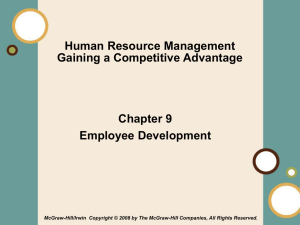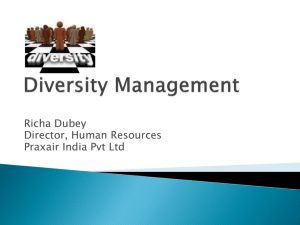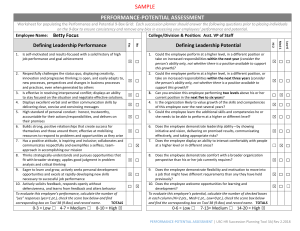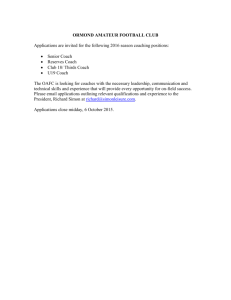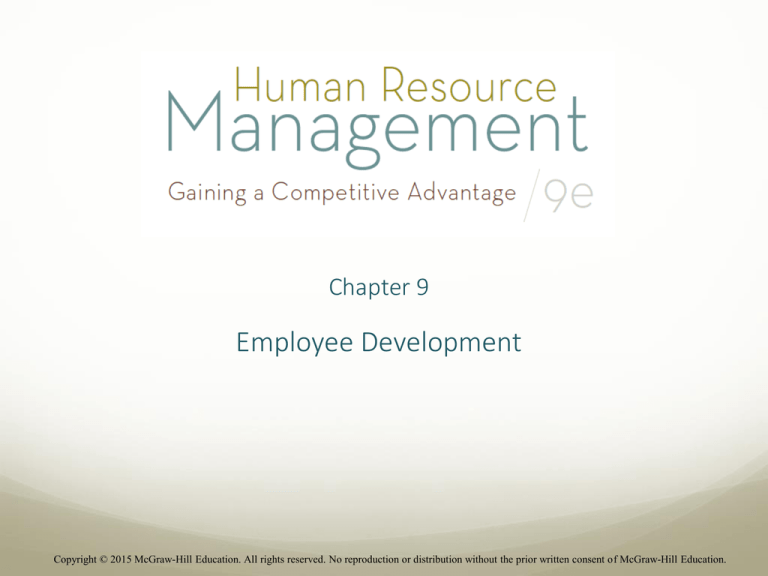
Chapter 9
Employee Development
Copyright © 2015 McGraw-Hill Education. All rights reserved. No reproduction or distribution without the prior written consent of McGraw-Hill Education.
Learning Objectives
1.
Explain how employee development contributes to strategies related to
employee retention, developing intellectual capital, and business growth.
2.
Discuss steps in the development planning process
3.
Explain the employees’ and company’s responsibilities in planning development.
4.
Discuss current trends in using formal education for development.
5.
Relate how assessment of personality type, work behaviors, and job performance
can be used for employee development
9-2
Learning Objectives, cont.
6. Explain how job experiences can be used for skill development.
7. Develop successful mentoring programs.
8. Describe how to train managers to coach employees.
9. Discuss what companies are doing for melting the glass ceiling.
10. Use the 9-box grid for identifying where employees fit in a succession plan and
construct appropriate development plans for them.
9-3
Training and Development Comparison
Training
Development
Focus
Current
Future
Use of work
experience
Low
High
Goal
Preparation for
Preparation for
current job
changes
Participation
Required
Voluntary
9-4
Careers
A protean career is based on self-direction with the goal of psychological success
in one’s work.
Psychological success - feeling of pride and accomplishment that comes from
achieving life goals.
Development planning system - retain and motivate employees by identifying
and meeting development needs. (also called career management system)
9-5
Boundaryless
“Boundaryless” - careers may involve identifying more with a job or profession
than with the present employer.
Career plans or goals are influenced by personal or family demands and values.
Employees can change their careers throughout their life based on awareness of
strengths and weaknesses, perceived need to balance work and life, and the
need to find stimulating and exciting work.
9-6
Steps and Responsibilities in the
Career Management Process Figure 9.1
Selfassessment
Reality
Check
Goal
Setting
Action
Planning
9-7
Examples of Development Plan Areas
Professional goals and motivation
Talents or strengths
Development opportunities
Development objectives and action steps
9-8
Employee Development Approaches
Formal Education
Assessments
Personality Tests and inventories such as
Myers-Briggs, (MBTI), etc.
Performance appraisals
Upward feedback
360-Degree Feedback Systems
Job Experiences
Interpersonal Relationships
9-9
Assessment Centers
An assessment center, usually off-site, uses multiple raters to
evaluate employees’ performance on exercises.
4 Types of Assessment Exercises:
1. Leaderless group discussion
2. Interviews
3. In-baskets
4. Role plays
9-10
Skills for Managerial Success
Do Whatever It Takes
Lead
Build & Mend Relationships
Develop
Team
Balance
Hire Talented Staff
Put Others at Ease
9-11
360-Degree Feedback Activities
Identify:
Development
Goal
9-12
Job Experiences for Career Development
Vertical Assignments
Lateral
Moves
9-13
Job Demands and Lessons Learned
Be involved in
non-authority
relationships
9-14
Job Experiences
Job enlargement-adding challenges or new responsibilities.
Job rotation-moving a single individual from one job to another.
Transfer-moving an employee to a different job assignment in a different area of
the company.
Promotions-advancement into positions with greater challenge and more
authority than previous job.
A downward move occurs when an employee is given a reduced level of
responsibility and authority.
9-15
Temporary Assignments
Externship refers to a company allowing employees to take a full-time
operational role at another company.
A sabbatical is a leave of absence from the company to renew or develop
skills.
9-16
Successful Mentoring Programs
Voluntary participation
Flexible matching process
Mentors chosen on ability & willingness
Clearly understood purpose
Program length specified
Minimum level of contact specified
Contact among participants encouraged
Program evaluated
Employee development rewarded
9-17
Benefits of Mentoring Relationships
Career Support
Coach, protect, sponsor and provide challenging assignments,
exposure and visibility.
Psychological Support
Serve as a friend and role model, provide positive regard and
acceptance and create an outlet for a protégé to share
anxieties and fears.
Group Mentoring Program
A program pairing successful senior employees with less
experienced protégés.
9-18
Coaching
A coach is a peer or manager who works with an
employee to:
motivate
develop skills
provide reinforcement and feedback
3 roles a coach can play:
1. one-on-one
2. help employee learn
3. provide resources such as mentors,
courses or job experiences
9-19
Career Management Process
Identify needs
realistic to
develop
Identify steps &
timetable to
reach goals
Identify
opportunities to
improve
Identify goals &
methods to
determine
progress
9-20
Development Plan
Co
mp
ete
nci
es/
stre
ngt
hs
Car
eer
Ne
dev
xt
elo
assi
pm
gn
ent
me
goa
nts
ls
Competencies &
Strengths
9-21
9-22
Melting the Glass Ceiling
9-23
Succession Planning
Succession planning is the identification and
tracking of high potential employees capable of
filling higher-level managerial positions.
High-Potential Employees - Employees the
company believes are capable of being successful
in high-level management positions
9-24
9-Box Grid
9-25
Summary
Development methods include formal education, assessment, job experiences
and interpersonal relationships.
Both employee and company have responsibilities.
A mentor can help employees better understand the company and gain exposure
to key persons.
A manager’s job responsibility is coaching.
Employees should have a development plan.
9-26

